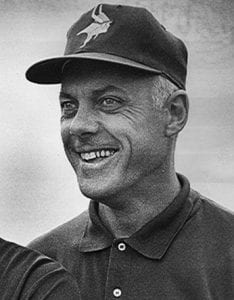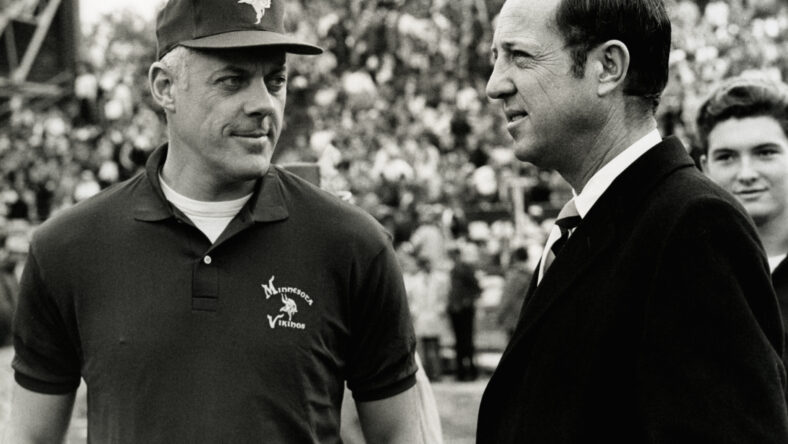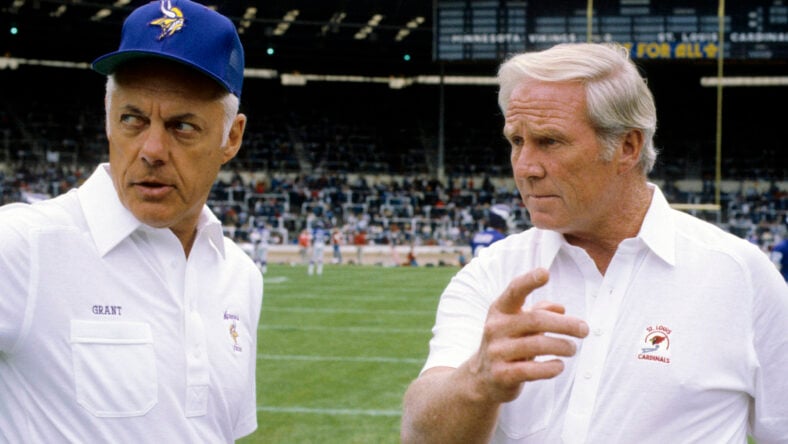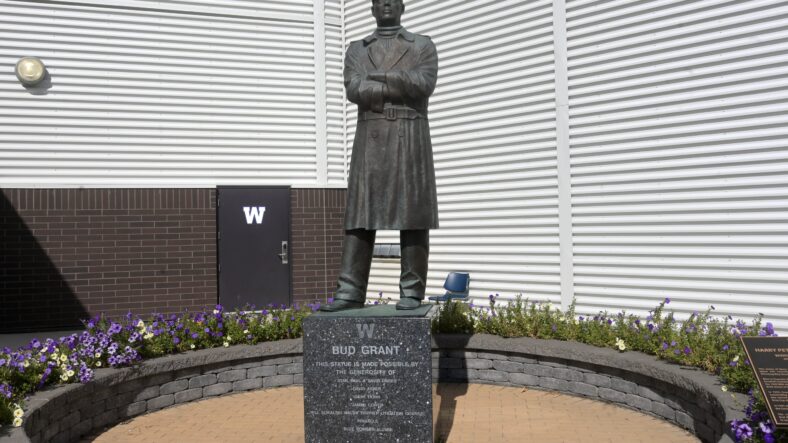The Vikings Hall of Fame Series: Bud Grant

The Minnesota Vikings have had 15 members inducted into the Pro Football Hall of Fame that played significant stretches of their career in purple. Perhaps none of these 15 men have left an impact on the organization quite like Harold Peter Grant, Jr., or as most Vikings fans know him as, Bud Grant.
Grant arrived in Minnesota in 1967 at the age of 40 after coaching for ten seasons for the Winnipeg Blue Bombers in the Canadian Football League. Before Grant came to Minnesota, the Vikings were 29-51-4 in their first six seasons. By Grant’s second season, Minnesota made their first playoff appearance in team history before losing to the eventual NFL champion Baltimore Colts, 24-14. Still, the Vikings had finally found their footing, and what ensued was the greatest ten-year reign in team history.

In 1969, Minnesota fielded one of the finest teams in NFL history. The team led the league in both points scored and points allowed and won the final NFL Championship before the AFL-NFL merger in 1970 when they defeated the Browns 27-7. Unfortunately, the Vikings would be upset in Super Bowl IV by the Kansas City Chiefs by a score of 23-7 in what became an all-too-familiar pattern. From there, the Vikings would advance to three more Super Bowls, losing to the Dolphins following the 1973 season (24-7), the Steelers following the 1974 season (16-6), and the Raiders following the 1976 season (32-14).
Unfortunately, these losses overshadowed the dominance the Vikings had from 1968 through 1978. In that 11-year stretch, Minnesota won the division ten times. They took a one-year hiatus in 1979 as well before winning one last division title for Grant on a Hail Mary pass from Tommy Kramer to Ahmad Rashad to end the 1980 season.
A large part of this dominant stretch came from the fact that the Vikings played their games at the open-air Metropolitan Stadium. Because they dominated the regular season, the Purple got to play many of their playoff games in frigid temperatures. In ten home playoff games, the Vikings were 7-3 at the Met.
Their dominance in the elements came from the leadership of Bud Grant. He got the team to buy into playing in the cold. As Grant put it, “Being cold is akin to being hot. You’re uncomfortable but you can function.” With this mindset, the Vikings did not employ heaters on their sidelines (they actually shared sidelines at the Met with the opposition, much like modern-day Pop Warner).
As insane as this sounds (which is kind of the point), Viking players never had to worry about huddling around heaters. Opposing teams, like the Los Angeles Rams who visited for three playoff bouts in the 1970s, were more focused on trying to stay warm, not on doing their jobs. When they looked across the field at Minnesota warming up without gloves and many players not donning sleeves, the Vikings already had the upper hand psychologically.
It may have come as no surprise, then, that the new era of Vikings football inside the Metrodome came around the same time that Grant walked away from coaching. The Dome opened in 1982, and Grant retired following the 1983 season. When Minnesota went 3-13 under Les Steckel in 1984, Grant decided to come back for one more season. In 1985, Grant righted the ship, getting the Vikings to 7-9 before retiring for good. He is still the winningest coach in Vikings history, going 158-96-5. He led the team to 11 division titles and won the inaugural home playoff games at both Metropolitan Stadium and the Metrodome.
Grant’s life goes well beyond just his time as the head coach of the Minnesota Vikings, though. Growing up, he was diagnosed with polio and actually developed a limp. To strengthen his muscles, he played sports. He went to college at the University of Minnesota, playing baseball, basketball, and football. He was drafted by the Philadelphia Eagles in 1949 as a first-round pick. But when he found out he could get paid to play basketball, he joined the local NBA team, the Minneapolis Lakers. Although the Lakers won the NBA title in each of Grant’s two seasons on the team, Grant knew he belonged on the gridiron.

When Grant suited up for the Eagles in 1951, he became the first, and still to this day, the only, person to ever play in both the NBA and the NFL. Grant spent his first season with the Eagles playing defensive end. He then switched positions to split end, which was the old-school version of today’s wide receiver. Grant excelled, catching 56 passes for 997 yards and seven scores in 1952. Those are solid numbers today, but they were still playing 12-game schedules in 1952. His 56 receptions and 997 yards each ranked second in the entire league.
Following the 1952 campaign, the Eagles and Grant couldn’t agree on a contract. When Grant felt like he wasn’t being offered what he thought he was worth, he went up north to play for the Blue Bombers in the CFL. After playing for the Blue Bombers for four seasons, Grant was offered the head coaching job following the 1956 season.
During Grant’s ten seasons as head coach, the Blue Bombers advanced to the CFL’s Grey Cup six times, winning four. His success didn’t go unnoticed down in the NFL. Prior to the 1961 campaign, Minnesota Vikings founder Max Winter contacted Grant and offered him the head coaching job of the expansion team. Grant, of course, declined, before taking the job six years later.
Grant’s Canadian tenure didn’t go unnoticed. He was inducted into the CFL Hall of Fame in 1983. He was finally inducted into the Pro Football Hall of Fame down in the States in 1994 as well, making him the only coach to be inducted into each.

The success Grant achieved came from understanding how to balance his professional and personal life. Grant said he’d never sleep in his office and would snow-shoe home in a blizzard just so he wouldn’t have to. At one point, he said, “I get more satisfaction providing for my family than I ever did coaching a football game.” Grant understood that sport was entertainment, not life or death.
This also translated into the famous “Viking Formation” where every player stood at attention for the national anthem on the sideline with their hand over their heart. Grant put Jim Marshall and Carl Eller in charge of keeping other players in line. Players said that Grant would forego football drills to practice the formation during the week.
On Saturday, March 11, 2023, Grant passed away at the age of 95. Fans both young and old offered their condolences. Former players and coaches spoke highly of the man who put the Vikings on the map. Kevin O’Connell shared a statement, saying that he met with Grant weekly during his first year as the Vikings’ coach.
With a unique perspective on how to live life and lead men, a quote that kept coming up from Grant was an old Chinese quote that he found in a newspaper during his coaching career. The quote came from Lao-Tse in 565 B.C. It perfectly encapsulates how Grant led the Vikings without screaming and berating players while also getting the most out of them.
“A leader is best when people barely know he exists. Not so good when people obey and acclaim him. Worse when they despise him. But of a good leader who talks little when his work is done his aim fulfilled they will say: ‘We did it ourselves.’”
Amen to that.
Note: This article was originally published at The Vikings Gazette.
